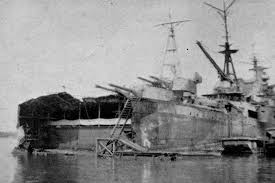What did the Japanese risk at Leyte Gulf?
1 Answer
At Leyte the Japanese strategically risked their oil supplies and tactically the remaining strength of their naval force and the possibility to protect the troops in the Philippines.
Explanation:
At Leyte the Japanese planners tried their last major aero-naval operation of huge dimension.
At least three different fleets were to converge on the American fleet to annihilate it (in particular the landing crafts and troop transports) while a fourth one (composed mainly of aircraft depleted carriers) was to function as decoy to lure the American carriers, cruisers and aircraft away from the landing crafts.
The Japanese intentions were twofold:
1) Protect their oil route: the Philippines were a kind of shield for the Japanese tankers going from the Dutch East Indies to Japan carrying the oil indispensable to carry on the war against the US;
2) Give a terrible blow to the American invasion forces: for the whole defensive portion of the Pacific War, the Japanese sought the famous "Final and Decisive Battle" that, in their plans, would have damaged the US fleet so much to render it inoperative for a long time allowing them to reach an honorable peace or to reinforce their defensive positions.
Obviously at the time of Leyte, the US had probably some 4 or 5 fleets completely equipped and battle-hardened to deal with...against few depleted and, at this moment old, fuel starving flotillas renamed as fleets!
The air force as well was of dubious utility; the Japanese had already lost their best pilots and the new pilots had superficial training and no flying experience at all because the lack of fuel (probably at this moment more pilots were killed by faulty aircrafts or mistakes during takeoff or landing than by enemy fire!).
Ufortunately the Japanese planned an operation too complicated and too dependent on the success of different events (the carriers bait didn’t work very well) and the Japanese commanders showed a strange and incredible lack of fighting spirit and enthusiasm.
The battle was a strategic and probably tactic victory for the US fleet that damaged and sunk many important Japanese ships and isolated the Japanese garrisons of the Philippines that from now on couldn’t expect any help and were, basically, engaged in a desperate kamikaze mission.
The effect of the battle is symbolized (I think) by the fact that the majority of the Japanese ships decided to retreat towards the ports in the oil producing occupied countries to be near the oil (that they were burning directly without refining) and so to be able to remain operative.

[Once proud Cruiser Myoko abandoned and wrecked at Singapore]

